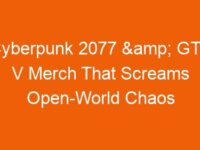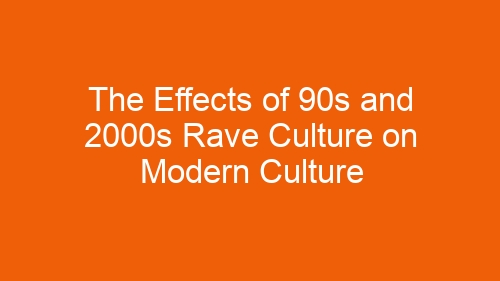-
Table of Contents
Influence of 90s and 2000s Rave Fashion on Current Trends
The rave culture of the 90s and 2000s left a lasting impact on modern culture, particularly in the realm of fashion. The vibrant and eclectic styles that emerged from this era continue to influence current trends, with many elements of rave fashion making a comeback in today’s streetwear and high fashion scenes.
One of the most iconic aspects of rave fashion from the 90s and 2000s was the emphasis on bright colors and bold patterns. Neon hues, tie-dye prints, and psychedelic designs were all staples of the rave wardrobe, reflecting the free-spirited and rebellious nature of the subculture. These eye-catching elements have resurfaced in recent years, with designers and brands incorporating them into their collections to create a sense of nostalgia and playfulness.
Another key component of rave fashion that has endured is the use of unconventional materials and textures. PVC, mesh, and metallic fabrics were popular choices for rave outfits, adding a futuristic and edgy touch to the overall look. Today, these materials can be seen in a variety of contemporary designs, from statement jackets to accessories like bags and shoes. The use of unconventional materials continues to push boundaries and challenge traditional notions of fashion.
Accessories also played a significant role in rave fashion, with items like chunky platform shoes, oversized sunglasses, and body jewelry becoming must-have items for ravers. These accessories not only added to the overall aesthetic of the outfit but also served as a form of self-expression and individuality. In recent years, we have seen a resurgence of these accessories in mainstream fashion, with chunky sneakers, statement sunglasses, and bold jewelry becoming popular choices for street style enthusiasts and influencers.
The influence of rave fashion from the 90s and 2000s can also be seen in the rise of athleisure wear. The emphasis on comfort and functionality that was prevalent in rave fashion has translated into the popularity of sportswear-inspired clothing in today’s fashion landscape. Brands like Adidas, Nike, and Puma have capitalized on this trend, creating collections that blur the lines between activewear and everyday attire. The fusion of fashion and function has resonated with consumers who value both style and comfort in their clothing choices.
Overall, the impact of 90s and 2000s rave culture on modern fashion is undeniable. The bold colors, unconventional materials, and playful accessories that defined this era continue to inspire designers and consumers alike, shaping the way we dress and express ourselves. As we look to the past for inspiration, we can see how the spirit of rave culture lives on in the vibrant and eclectic styles of today. Whether it’s through a neon crop top, a pair of chunky sneakers, or a statement accessory, the influence of rave fashion is here to stay.
Impact of Rave Music on Contemporary Electronic Dance Music
The rave culture of the 90s and 2000s had a profound impact on modern culture, particularly in the realm of electronic dance music (EDM). The energetic and euphoric atmosphere of raves, fueled by pulsating beats and hypnotic melodies, has left a lasting imprint on the music scene of today. The influence of rave music can be seen in the evolution of EDM, with many artists drawing inspiration from the sounds and styles of the past.
One of the key effects of 90s and 2000s rave culture on modern EDM is the emphasis on high-energy, danceable tracks. Rave music was all about creating a sense of euphoria and unity on the dance floor, and this ethos has carried over into contemporary EDM. Artists like The Chemical Brothers, The Prodigy, and Fatboy Slim were pioneers of this style, blending elements of techno, house, and breakbeat to create infectious, pulse-pounding tracks that kept ravers moving all night long.
Another impact of rave culture on modern EDM is the use of technology to push the boundaries of sound. In the 90s and 2000s, DJs and producers began experimenting with new equipment and software to create innovative and cutting-edge music. This spirit of innovation continues to drive the EDM scene today, with artists constantly pushing the limits of what is possible with electronic music. From complex synthesizer patterns to intricate drum programming, the influence of rave culture can be heard in the intricate and detailed production of modern EDM tracks.
The sense of community and inclusivity that defined rave culture in the 90s and 2000s has also had a lasting impact on modern EDM. Raves were places where people from all walks of life could come together to dance, connect, and celebrate their love of music. This spirit of unity and acceptance is still present in the EDM scene today, with festivals and events serving as gathering places for fans to come together and share their passion for electronic music.
The visual aesthetic of rave culture has also left its mark on modern EDM. The bright colors, bold graphics, and psychedelic imagery that were synonymous with raves in the 90s and 2000s can still be seen in the artwork and visuals associated with EDM artists and events. From vibrant stage designs to eye-catching album covers, the visual language of rave culture continues to influence the look and feel of the EDM scene.
Overall, the effects of 90s and 2000s rave culture on modern EDM are undeniable. The high-energy, innovative music, sense of community, and visual aesthetic that defined the rave scene of the past continue to shape the electronic music landscape of today. As artists continue to draw inspiration from the sounds and styles of the past, the legacy of rave culture lives on in the pulsating beats and euphoric melodies of contemporary EDM.
Evolution of Rave Culture into Mainstream Festivals and Events
Rave culture emerged in the 1990s and 2000s as a subculture that celebrated electronic music, dancing, and a sense of community. Raves were often held in underground venues, warehouses, or outdoor spaces, with attendees dressed in colorful and eccentric clothing, adorned with glow sticks and face paint. The atmosphere was characterized by a sense of freedom, self-expression, and unity among participants.
As rave culture gained popularity, it began to influence mainstream culture in various ways. One of the most significant impacts was the evolution of rave culture into mainstream festivals and events. These events, such as Electric Daisy Carnival, Ultra Music Festival, and Tomorrowland, have become massive gatherings that attract thousands of attendees from around the world.
The transition of rave culture into mainstream festivals has brought electronic music to a wider audience and has helped to shape the modern music industry. DJs and producers who were once underground figures are now headlining major festivals and topping the charts. The popularity of electronic dance music (EDM) has skyrocketed in recent years, with artists like Calvin Harris, Avicii, and Skrillex achieving mainstream success.
In addition to music, the fashion and aesthetic of rave culture have also influenced mainstream culture. Bright colors, neon lights, and futuristic designs have become popular in fashion, art, and design. Brands like Adidas, Nike, and H&M have released collections inspired by rave culture, featuring bold patterns, metallic fabrics, and oversized silhouettes.
The sense of community and inclusivity that was central to rave culture has also permeated mainstream culture. Festivals and events now emphasize diversity, acceptance, and unity among attendees. Many festivals promote values of peace, love, and unity, echoing the ethos of the original rave scene.
Despite its mainstream success, rave culture has faced criticism and controversy. Some critics argue that mainstream festivals have become too commercialized and focused on profit rather than the original values of rave culture. Others raise concerns about drug use, safety, and environmental impact at these events.
In response to these criticisms, some festivals have implemented harm reduction measures, such as drug testing services, medical tents, and educational programs. Organizers are also taking steps to reduce their environmental footprint by promoting sustainability, recycling, and eco-friendly practices.
Overall, the evolution of rave culture into mainstream festivals and events has had a profound impact on modern culture. It has brought electronic music to a wider audience, influenced fashion and design trends, and promoted values of community and inclusivity. While there are challenges and criticisms to address, the legacy of rave culture continues to shape the cultural landscape in meaningful ways.




















